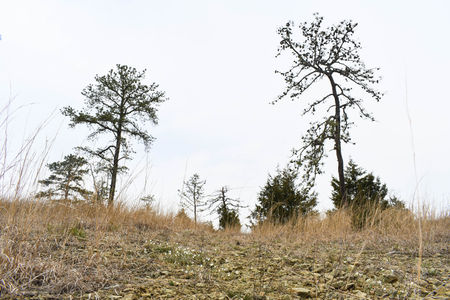Serpentine Barrens: Difference between revisions
No edit summary |
|||
| Line 1: | Line 1: | ||
[[File:SBW-1.jpg|right|450px|"Goat Hill Serpentine Barrens in SE Pennsylvania. Photo taken by Josh Klostermann"]] | [[File:SBW-1.jpg|right|450px|"Goat Hill Serpentine Barrens in SE Pennsylvania. Photo taken by Josh Klostermann"]] | ||
Serpentine Barrens are unique ecoregions that can be found globally, in patchy | Serpentine Barrens are unique ecoregions that can be found globally, in small patchy pockets of land with serpentine [[bedrock]] and [[soil]]. The term "serpentine barren" generally refers to a serpentine outcrop and its associated vegetation. These habitats are notable for their distinct vegetation with high rates of endemism. The difference in vegetative communities is the product of chemical, physical, and biotic edaphic factors but is primarily driven by the toxic chemical composition of the serpentine bedrock and soil. These systems are used to study edaphic endemism and plant speciation. [ ] They are also used as an analog to brownfields in restoration [[ecology]] because of the high heavy metal content in the soil. [ ] | ||
==Rock and Soil formation:== | ==Rock and Soil formation:== | ||
Revision as of 13:09, 2 May 2021

Serpentine Barrens are unique ecoregions that can be found globally, in small patchy pockets of land with serpentine bedrock and soil. The term "serpentine barren" generally refers to a serpentine outcrop and its associated vegetation. These habitats are notable for their distinct vegetation with high rates of endemism. The difference in vegetative communities is the product of chemical, physical, and biotic edaphic factors but is primarily driven by the toxic chemical composition of the serpentine bedrock and soil. These systems are used to study edaphic endemism and plant speciation. [ ] They are also used as an analog to brownfields in restoration ecology because of the high heavy metal content in the soil. [ ]
Rock and Soil formation:
Evolution and soil edaphic endimism:
Vegetative communities growing in serpentine barrens differ from surrounding areas by having a notably distinct physiognomy and community structure, low species richness, a dominance of specific taxa, a predominance of xerophytic species, low productivity, the co-existence of high and low ph-tolerant species, and high rates of endemism.
East Coast Serpentine Barrens:
Add map of barrens. Briefly describe history + formation
Flora:
Photos reel of plants. Plant list.
Threats and Restoration Efforts:
Invasive species, fire